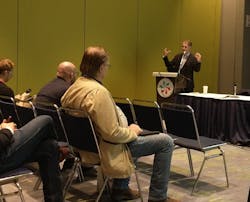2024 AHR Expo: Hydronic Snow and Ice Melting System Design to Optimize Performance and Efficiency
Hydronic snow and ice melt (SIM) systems are installed outside under driveways, sidewalks, ramps, stairs, etc., to prevent slips and falls that could cause injury. Many hospitals, schools, senior facilities, and commercial buildings install them for safety – and to reduce liability.
"The safety, convenience, and savings provided by a SIM system are more beneficial than ever, as changing weather patterns increase snowfall in many regions," noted Lance MacNevin, director of engineering in the Plastics Pipe Institute's Building and Construction Division, Jan. 24 at the 2024 AHR Expo in Chicago.
Other relevant issues include:
- Clearing slippery outdoor surfaces over a long winter is a high maintenance cost and involves the expense of harsh chemicals, which can damage surfaces.
- Aging populations need access to services, yet may have limited mobility.
- Snow and ice melting systems can reduce liability while improving access.
- Operating costs for a hydronic SIM system are often much less than mechanical snow removal, saving facility owners money while reducing risks.
MacNevin listed SIM's benefits:
- Better safety, keeping surfaces clear during snowfall events and evaporating water to prevent freezing;
- Reduced liability as residences and businesses free of snow and ice improve access and safety while eliminating a source of liability risk in winter.
- Healthier convenience, leaving them dry, and eliminating potential health risks of aching backs and heart attacks for homeowners.
- Lowered maintenance costs as hydronic SIM systems are usually less expensive to operate than mechanical removal.
- Minimized environmental impact as hydronic SIM systems are powered by heat sources such as high-efficiency boilers, electricity, thermal solar, geothermal heat pumps, or waste heat.
- Long-term liability as plastic tubing does not corrode on the inside or outside, and hydronic boilers, circulators, and piping components are highly reliable.
He discussed installation techniques and typical applications for SIM, then explained SIM design steps:
- Select the appropriate performance level for the customer.
- Determine the required heat output/heat flux.
- Select and size heat source to meet the peak load.
- Design the piping distribution system in terms of size, spacing, and circuit lengths.
- Size hydronic equipment such as circulator pumps, expansion tanks, etc.
MacNavin concluded his session by explaining SIM control strategies and operation costs.
About the Author

Kelly L. Faloon
Freelance Writer/Editor
Kelly L. Faloon is a contributing editor and writer to Contractor, Contracting Business magazine and HPAC Engineering and principal of Faloon Editorial Services. The former editor of Plumbing & Mechanical magazine, Faloon has more than 26 years of experience in the plumbing and heating industry and more than 35 years in B2B publishing. She started a freelance writing and editing business in 2017, where she has a varied clientele.
Faloon spent 3 1/2 years at Supply House Times before joining the Plumbing & Mechanical staff in 2001. Previously, she spent nearly 10 years at CCH/Wolters Kluwer, a publishing firm specializing in business and tax law, where she wore many hats — proofreader, writer/editor for a daily tax publication, and Internal Revenue Code editor.
A native of Michigan’s northern Lower Peninsula, Faloon is a journalism graduate of Michigan State University. You can reach her at [email protected].
